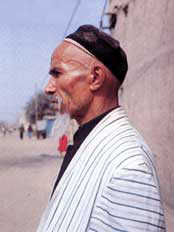 The Uygur, with a total population of 7.22 million (by 1990), have lived at the foot of Tianshan Mountain for several centuries. They used to colonize in the north and northwest region of China, suffering from the wars between tribes, before migrating to the Western Regions (present Xinjiang Uygur Autonomous Region). Some Uygurs scatter in counties of Hunan Province.
The Uygur, with a total population of 7.22 million (by 1990), have lived at the foot of Tianshan Mountain for several centuries. They used to colonize in the north and northwest region of China, suffering from the wars between tribes, before migrating to the Western Regions (present Xinjiang Uygur Autonomous Region). Some Uygurs scatter in counties of Hunan Province.
The Uygur ethnic minority has its own language and alphabet, which belongs to the Turki Austronesian of Altai Phylum. They have two written languages, one is based on Arabian letters, and the other based on Latin letters, the latter of which was created after the founding of the PRC.
In their language, "Uygur" means "unity" or "alliance". The origin of the ethnic minority can be traced back to the Dingling nomads in northern and northwestern China and in areas south of Lake Baikal and between the Irtish River and Lake Balkhash in the third century BC. The Dingling were later called the Tiele, Tieli, or Chile. They established the Huihe Khanate in the 7th century.
These ancient Uygur people were finally conquered by Turkic Kirghiz in the mid-ninth century. The majority of the Uygurs moved to the Western Region (present-day Xinjiang area). Some went to the Tufan principality in western Gansu Province. They intermarried with people in southern Xinjiang and Tibetan, the Hans, Turkic nomads, Qidan (Khitan) and Mongol tribes, and evolved into the group now known as the Uygurs. The Xinjiang Uygur Autonomous Region was formally established on October 1, 1955.
Mainly involved in agriculture, the Uygurs are also skilled in growing cotton, breeding silkworms, and spinning and weaving. The largest grape base of China is located in the Turpan Basin.
The Uygur culture has a long and rich tradition. Many folk tales, parables, comedies, poems and proverbs praise the courage, wisdom and kindness of the ordinary people, while satirizing the greed, cruelty and foolishness of the exploiting classes. For instance,The Tales of Afandicontains stinging satire about the Bayis and Imams who bully the people. The Uygurs are excellent at dancing; the12 Mukams(opera) is an epic comprising more than 340 classic songs and folk dances.
The Uygur dances, such as the "Bowls-on-Head Dance", "Drum Dance", "Iron Ring Dance" and "Puta Dance", feature light, graceful and quick-swinging choreography movements. The "Sainaim Dance" is the most popular.
The Uygur musical instruments include the Dutar, Rawap and Dap. The first two are instruments with a clear and crisp tone for solo and orchestral performances. Dap is a sheepskin tambourine with many small iron rings attached to the rim; it is used to accompany dancing.
The Uygurs are believers of the Islamic faith. The Corban Festival, the Noroz Festival, the Kaizhai Festival and the Nuolu Festival are the most important festivals to the Uygur people.
